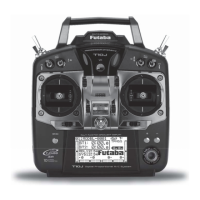90
S.BUS Servo Description of function of each parameter
*There are a function which can be used according to the kind of servo, and an impossible function.
• ID
Displays the ID of the servo whose parameters are to be read. It cannot be changed.
• Channel
Channel of the S.BUS system assigned to the servo. Always assign a channel before use.
• Reverse
The direction in which the servo rotates can be changed.
• Servo type
When "Retractable" is selected and the servo has been continuously stopped for 30 seconds, the dead
band expands and unnecessary hold current due to external force is eliminated. When a new control
signal enters, normal operation is resumed. When using the servo as a landing gear servo, select
"Retractable". Also adjust the servo travel to match the landing gear movement range.
• Soft Start
Restricts operation in the specied direction the instant the power is turned on. By using this setting, the
rst initial movement when the power is turned on slowly moves the servo to the specied position.
• Stop Mode
The state of the servo when the servo input signal is lost can be specied. The "Hold" mode setting holds
the servo in its last commanded position even if using AM or FM system.
• Smoother
This function changes smoothness of the servo operation relative to stick movement changes. Smooth
setting is used for normal ight. Select the "OFF" mode when quick operation is necessary such as 3D.
• Neutral Oset
The neutral position can be changed. When the neutral oset is large value, the servo's range of travel is
restricted on one side.
• Speed Control
Speeds can be matched by specifying the operating speed. The speed of multiple servos can be matched
without being affected by motor fluctuations. This is effective for load torques below the maximum
torque.
However, note that the maximum speed will not be exceed what the servo is capable of even if the
servos operating voltage is increased.
• Dead band
The dead band angle at stopping can be specied.
[Relationship between dead band set value and servo operation]
Small
→
Dead band angle is small and the servo is immediately operated by a small signal change.
Large
→
Dead band angle is large and the servo does not operate at small signal changes.
(Note) If the dead band angle is too small, the servo will operate continuously and the current
consumption will increase and the life of the servo will be shortened.
• Travel Adjust
The left and right travels centered about the neutral position can be set independently.
• Boost
The minimum current applied to the internal motor when starting the servo can be set. Since a small
travel does not start the motor, it essentially feels like the dead band was expanded. The motor can be
immediately started by adjusting the minimum current which can start the motor.
[Relationship between boost set value and servo operation]
Small
→
Motor reacts to a minute current and operation becomes smooth.
Large
→
Initial response improves and output torque increases. However, if the torque is too large,
operation will become rough.

